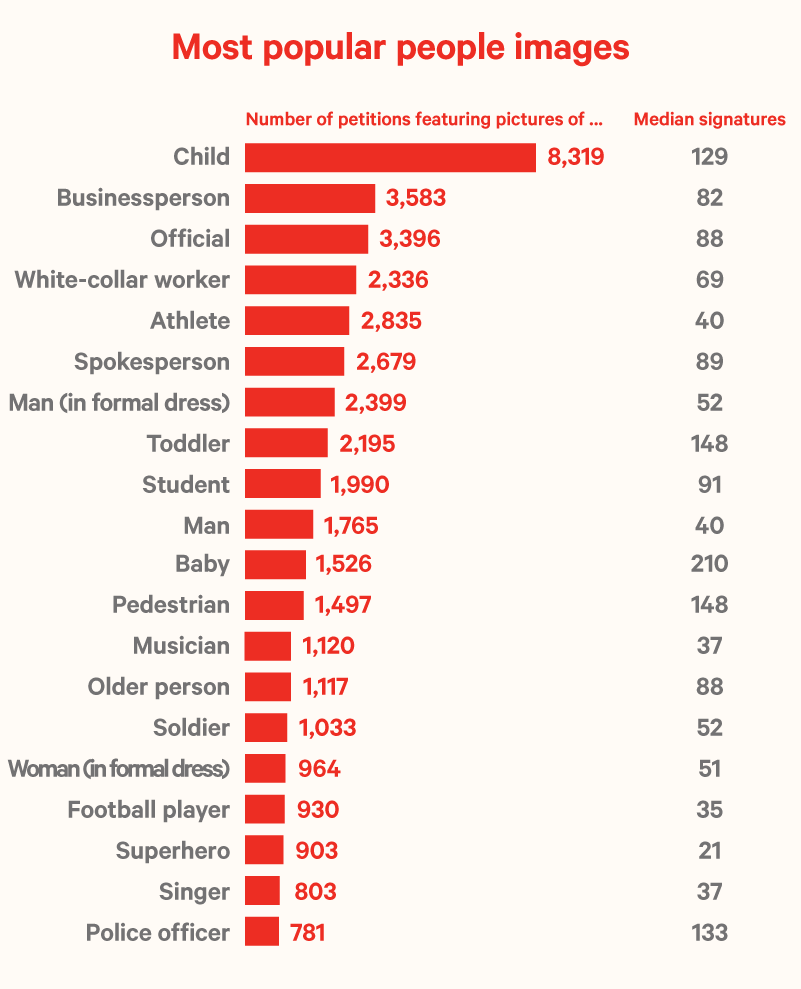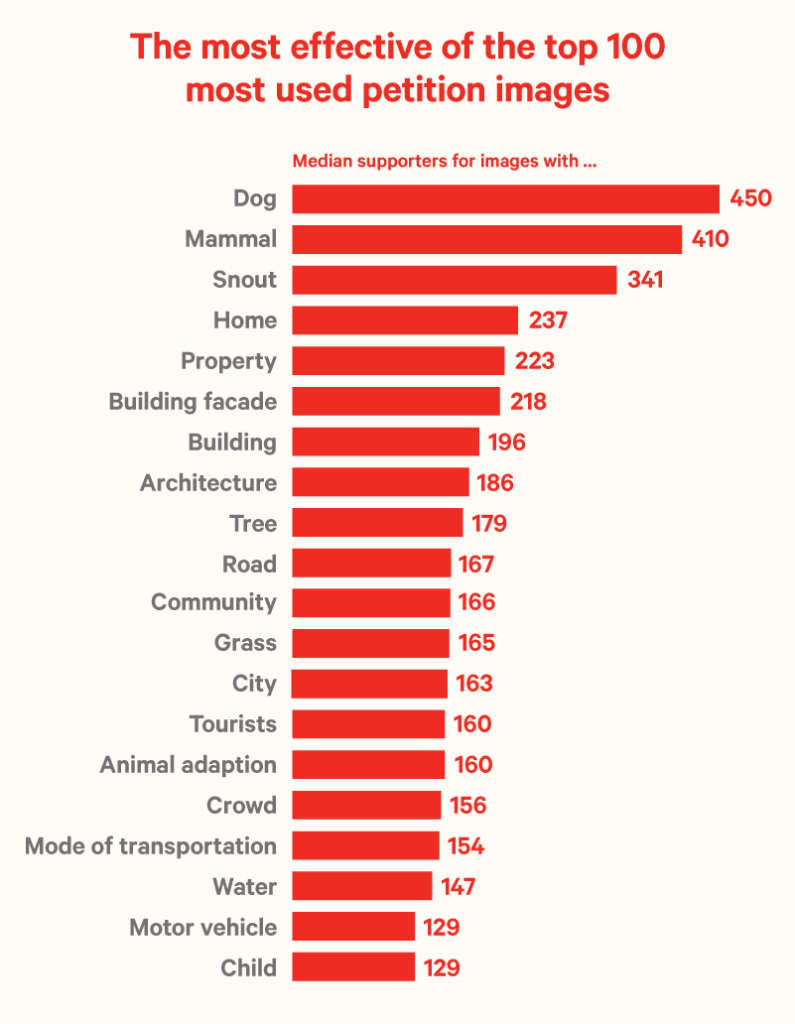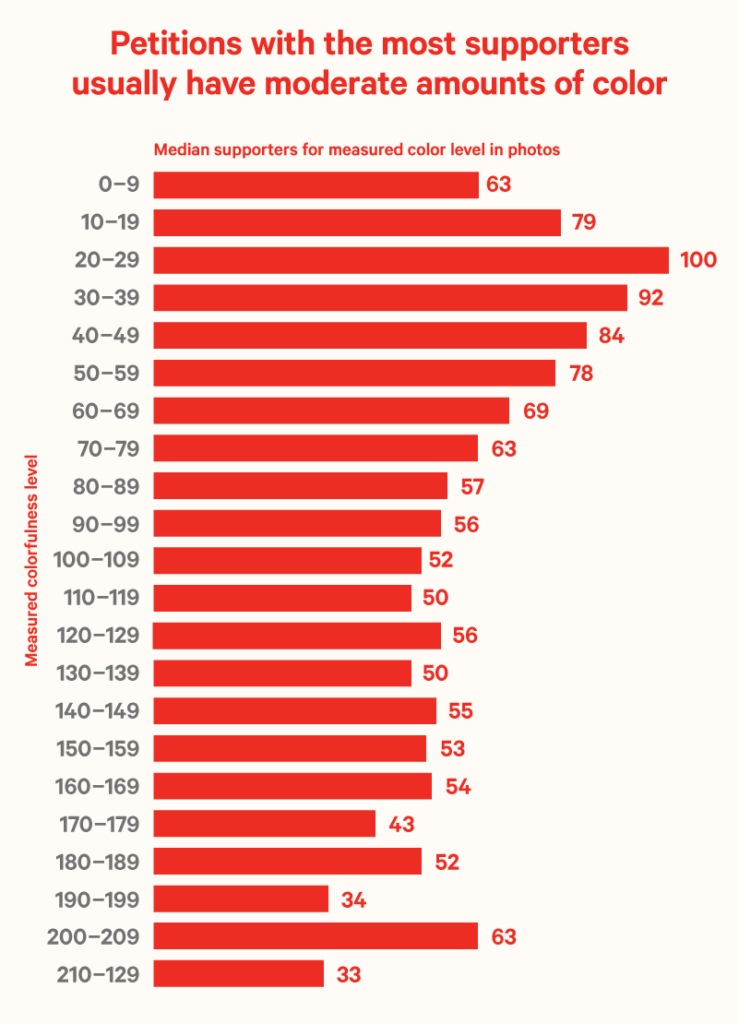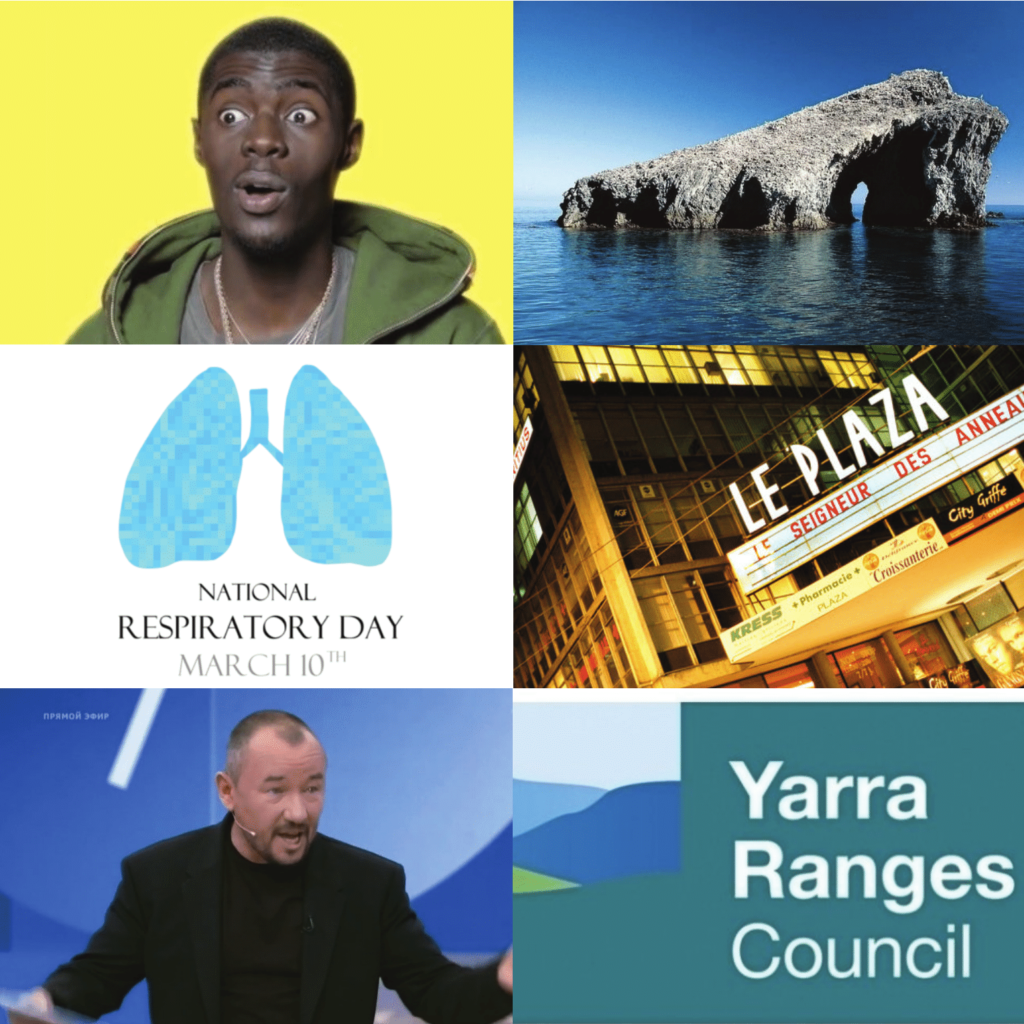The right cover photo, paired with a compelling headline, can be the difference between catching the attention of a new supporter or people scrolling past your petition. There are some basic best practices, such as using an image that measures 1,600 pixels by 900 pixels so that the photo displays well on all screen sizes. Also, check with the image’s owner or photographer to make sure you have permission to use any photos that you did not take.
The best photos will capture an emotion. If you can’t take a picture that complements your petition, or if you don’t have a license to use photos of the places or people involved in your petition, there are still some decisions that you can make when choosing stock photography or creating a visual to ensure that you capture the attention of potential supporters. This guide is meant to help you understand some research-based best practices for choosing the best possible image to accompany a petition you start on Change.org, but these insights also apply to all forms of online activism and making sure your message gets the attention of the greatest number of possible supporters.
Effective image subjects
To dive deeper into what makes images effective, we examined a dataset of nearly 2 million photos featured in Change.org online petitions over the last several years. For each image, we identified the subjects and objects in the photographs, the emotional nature of facial expressions, and analyzed the brightness and color composition of each image to see if any of these correlated with above-average petition performance. Having some kind of image is critically important: Using a minimum cutoff of five supporter signatures, the median number of signatures for a petition with images was 78, compared to a median of 42 signatures for petitions overall. Of course, this number includes a wide range of petitions, from those with just a handful of supporters to some viral petitions that earned several million signatures.
Of the images of objects detected 100 or more times in Change.org petitions, a few stood out as being particularly effective. Animal petitions and animal rights were particularly popular on Change.org. A separate analysis of animal petitions showed that four of the top five images related to animal rights and animals housed in poor conditions. Animal shelters, kennels, cages, and zoos received an average of more than 1,100 signatures per petition. Endangered animals, stray dogs, and petitions for working animals or animal-related sports rounded out the top of the list.
Images featuring elements of nature were also popular petition photo choices. Photos of the sky, trees, and plants were the most common and could be found in about half of all nature-related petition images, which makes sense – those objects would be detected in almost any picture of a city or natural landscape. Water and grass could be found in a quarter of the photos, followed by more specific objects, such as nature reserves and the atmosphere.

We ran a separate analysis to find the most common people in petition images and found that over a third of images included a child. Businesspeople and white-collar professionals, including officials and spokespeople, were also common. Surprisingly, there were more photos of superheroes than police officers in petition images, even though police officers were included in many protest images.

A photograph won’t determine whether a petition succeeds or fails; if your petition affects a small but invested group of people, it can be hard to get the word out to the community and galvanize support. Activism is personal, and the key to success is making a connection with people who will support your cause. Some petitions campaign for the addition or removal of emoticons. Images with emoticons or smiley faces acting as fillers can easily be replaced with images that inspire – rather than convey – emotion. If you feel like you’ve gained a sense of how to use a photo to inspire others and have a cause you’d like to support, you can start a petition on Change.org here.
Change.org’s most popular petition images
Pictures of homes, faces, and animations or illustrations were popular among petition writers, but an image’s popularity does not necessarily mean that it will be effective.

Of the most popular petition images on Change.org, animals – presumably related to animal rights petitions – again dominated the top of the list. Pictures of buildings, neighborhoods, and places where people live also performed well. When combined with an effective headline and thoughtful text, those images can evoke a strong sense of place and inspire viewers to take action. Familiar objects, like pictures of homes and children, are relatable and can strike an emotional chord in potential supporters.

Despite their ubiquity, some popular images seemed to do little to inspire petition signatures. The line between animations and cartoons can be vague; generally, illustrations encompass hand drawings, as well as logos and graphics created digitally with professional design software. One possible reason for the low number of median signatures could be that many of the images are grainy or appear to have been hastily created using tools like Microsoft Paint. Paired with screenshots, clip art, and selfies, which also ranked poorly, these low-performing images could indicate a lack of effort in finding petition images, which will be broadcast to potential supporters.
A few extra points on faces before you start your petition. In this image categorization, “faces” are not profile pictures: They are too-close, tightly cropped images, where only a fraction of the face or head is visible. Vertical or square portrait images that are cropped to fit the landscape dimensions of online images generally land in this category. If cropping a vertical image cuts out parts of the head or face, consider choosing another image.
Try smiling
A picture of a smiling person will not be appropriate for every petition, but if you have the choice between a picture of someone who appears happy or sad, opt for the happier photo. An analysis of petition photos showed that happy faces were more common than any other facial expression in petition images, and with good reason: Smiling photos may be the most effective. Petitions with photos of people who appeared happy got more support than petitions of people wearing neutral or sad expressions. On average, happy faces received 24 more signatures than neutral facial expressions and 35 more than fearful or sad photos.
In a petition to reinstate the comment section for the Special Books by Special Kids (SBSK) YouTube channel, the organization chose to use a happy picture of one of the kids, rather than a sad or distraught photo. The happy photo helps set a positive, hopeful tone for the petition, and the petition ultimately received support from more than half a million people.

The right amount of color
You may not have a lot of control over whether you can get a license to use a professional image, but one simple decision that petition writers can control is the colorfulness of the image featured on the petition.
In the world of online petitions, there is such a thing as too much color. We analyzed our image dataset to compute “colorfulness” (according to Hasler and Süsstrunk, 2003), a measure of saturation and color contrast on a scale of zero to 210 in colorfulness. Highly saturated colors will be bright and receive higher color scores, whereas monochromatic, sepia tone, or grayscale images will rank on the lower end of the scale. Black-and-white images were ranked at zero, and images that featured primary colors with full saturation fell toward the top end of the spectrum, around 210.

In general, the images with a color score of 20 to 29 – less colorful images – were correlated with more successful petitions. That level of color corresponds with images of the real world that look the most realistic.



The success of the outlier images in the 95 to 120 color rating range reflects viral petitions and a combination of successful writing and social media promotion more than the effectiveness of more colorful petition photos. A #JusticeForAudrey petition, demanding that 12 Indonesian girls be held accountable for the alleged (and possibly fabricated) beating of another high school student, received nearly 4 million signatures. Annee Schwank, a professional illustrator, designed the petition photo, but in the case of these high-performing petitions, the preexisting social media presence of the cause likely contributed more to the petition’s success than the cover image.

Other petitions that broke 2 million signatures included a petition against salary increases for Portugal’s supreme federal court, one against raising the retirement age in Russia, one for a dog allegedly killed by a supermarket employee, and one against internet censorship. While we generally recommend avoiding adding text to images, these images represent effective exceptions. Of the top five petitions, four featured primary colors, and three included text overlaid on the image.

Animations and illustrations generally do not perform well, but the graphics in these viral petitions are well-designed and match the petition. For instance, it can be difficult to take a picture that encapsulates the issue of internet censorship, so a well-designed graphic can be a smart choice. Rather than using bright blue and bright yellow, which would have pushed the image closer to the 200-mark of colorfulness, the designer chose more muted colors. The contrast between the text and background is easy to read, and the image is simple and crisp.
Closing thoughts
Adding an image is one of the easiest ways to gain visibility and supporters for your petition. While choosing a perfect image may feel daunting, a few simple guidelines can help you along the way. Identify which emotion your petition should evoke, whether it’s outrage at a legal injustice or empathy for a vulnerable group of people, and then find an image that captures it. Choose well-composed, high-definition photos, rather than grainy screenshots or hasty illustrations: If your photo looks like an afterthought, viewers might treat your petition as one. Finally, remember that color is important, and images of real people and real places tend to perform best.
Ready to start a petition on Change.org?
Nick Allardice is the Chief Product Officer at Change.org. Twitter, LinkedIn.
Methodology Notes
For the bar chart, we set the cutoff for facial expressions at 75%. We chose that threshold by making histograms for each facial expression and looking for a natural break in the data. The bars represent the median votes per petition.
Data for this project were provided by Change.org and then treated to facial recognition analysis and image color detection with pyimagesearch. Statistical calculations and visualizations were created using pandas and matplotlib.

